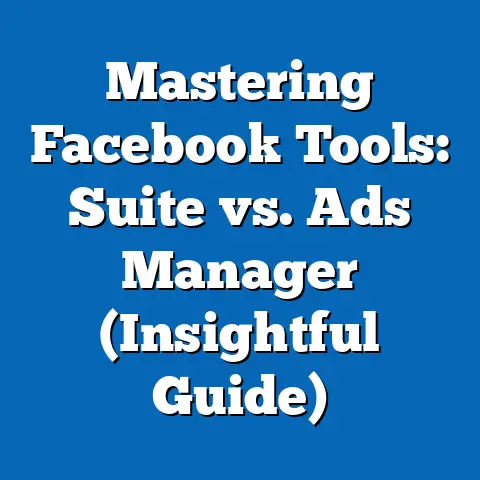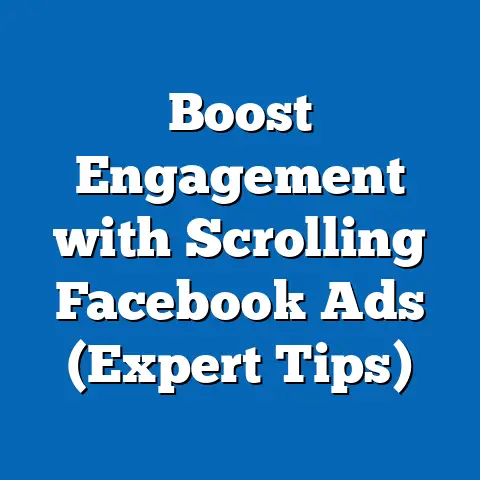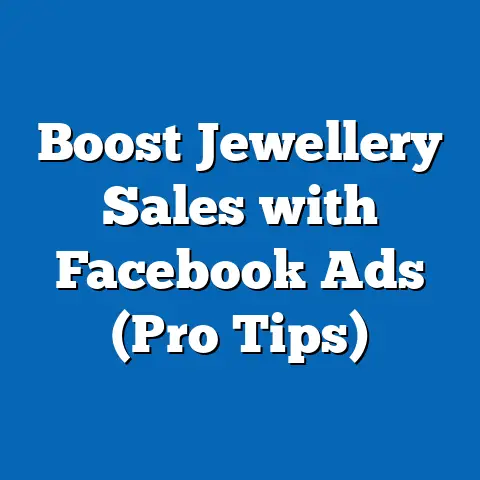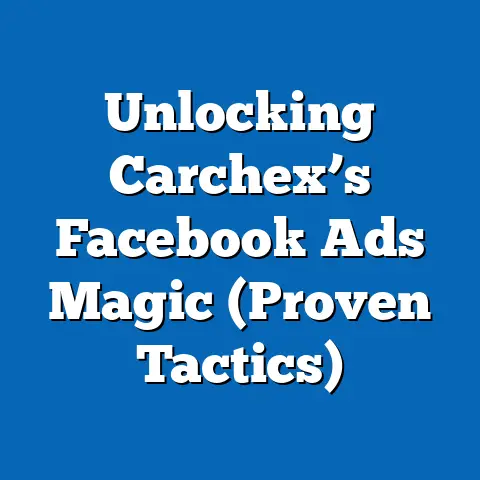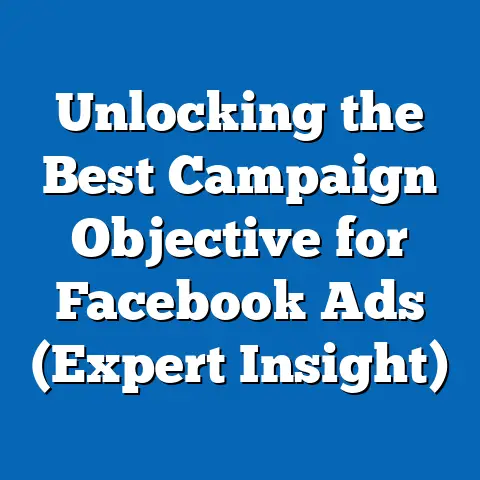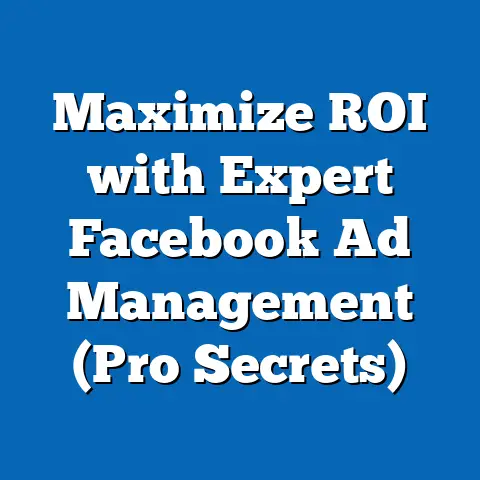End Facebook Ads with Adblock? (Essential Insights Revealed)
It’s a question that keeps many of us digital marketers up at night: are ad blockers slowly but surely rendering our carefully crafted Facebook ad campaigns useless? Did you know that over 615 million devices globally are using ad blockers, and a significant portion of these users are active on Facebook? That’s a staggering number, and it’s one that demands our attention. As someone who’s spent years navigating the ever-changing landscape of Facebook advertising, I’ve seen firsthand how ad blockers can throw a wrench into even the most meticulously planned strategies.
In this article, I’ll dive deep into the world of ad blockers, exploring their impact on Facebook ads, user behavior, and the future of advertising on the platform. I’ll share insights, real-world examples, and potential solutions to help you navigate this complex challenge and ensure your Facebook advertising efforts continue to deliver results.
Understanding Ad Blockers
Ad blockers are software applications or browser extensions designed to prevent advertisements from appearing on websites and within apps. They work by filtering out content based on predefined rules, often targeting specific HTML elements, JavaScript code, or network requests commonly associated with ads. The primary function is to improve the user experience by removing distracting, intrusive, and sometimes malicious advertisements.
Think of it like this: imagine you’re walking down a busy street, and every few steps, someone shoves a flyer in your face. Annoying, right? Ad blockers are like having a personal assistant who discreetly intercepts those flyers, allowing you to enjoy your walk in peace.
Users install ad blockers for a variety of reasons, including:
- Improved browsing speed: Ads can slow down page load times, especially on mobile devices.
- Reduced data consumption: Ads consume bandwidth, which can be a concern for users with limited data plans.
- Enhanced privacy: Some ads track user behavior, raising privacy concerns.
- Elimination of intrusive ads: Pop-ups, auto-playing videos, and other disruptive ad formats can be highly annoying.
- Protection against malware: Malicious ads can sometimes spread malware.
According to Statista, ad blocker usage has been steadily increasing over the years. While desktop usage has plateaued somewhat, mobile ad blocking is on the rise. It’s estimated that over 40% of internet users globally use some form of ad blocker. While precise figures for Facebook users who specifically use ad blockers are difficult to obtain, it’s safe to assume that a significant portion of Facebook’s massive user base is actively blocking ads. This is especially true among younger demographics who are more tech-savvy and privacy-conscious.
Takeaway: Ad blockers are a prevalent and growing force in the digital landscape, driven by a desire for a better, faster, and more private online experience.
The Impact of Ad Blockers on Facebook Ads
The presence of ad blockers has a direct impact on Facebook’s advertising ecosystem. When users block ads, it affects ad visibility, engagement metrics, and ultimately, the effectiveness of advertising campaigns. Here’s how:
-
Reduced Reach: Ad blockers prevent ads from being displayed to a segment of your target audience, effectively shrinking your potential reach. This means fewer people are seeing your ads, which can impact brand awareness and lead generation.
-
Lower Engagement: If ads aren’t being seen, they can’t be clicked, liked, or shared. This leads to lower engagement rates, which can negatively impact your ad relevance score and increase your ad costs.
-
Inaccurate Reporting: Ad blockers can skew your reporting data. For example, if a user blocks your ad, Facebook may still count it as an impression, even though it wasn’t actually seen. This can lead to inaccurate metrics and make it difficult to accurately assess the performance of your campaigns.
-
Financial Impact: Facebook generates the vast majority of its revenue from advertising. The more users block ads, the less revenue Facebook earns. This can, in turn, influence Facebook’s advertising policies and pricing structures.
Reduced Reach: Ad blockers prevent ads from being displayed to a segment of your target audience, effectively shrinking your potential reach. This means fewer people are seeing your ads, which can impact brand awareness and lead generation.
Lower Engagement: If ads aren’t being seen, they can’t be clicked, liked, or shared. This leads to lower engagement rates, which can negatively impact your ad relevance score and increase your ad costs.
Inaccurate Reporting: Ad blockers can skew your reporting data. For example, if a user blocks your ad, Facebook may still count it as an impression, even though it wasn’t actually seen. This can lead to inaccurate metrics and make it difficult to accurately assess the performance of your campaigns.
Financial Impact: Facebook generates the vast majority of its revenue from advertising. The more users block ads, the less revenue Facebook earns. This can, in turn, influence Facebook’s advertising policies and pricing structures.
I remember one campaign I ran for a local restaurant. We were targeting users within a 5-mile radius of the restaurant, and the initial results were promising. However, after a few weeks, the campaign’s performance started to decline. Upon closer inspection, I realized that a significant portion of our target audience was using ad blockers. This meant that our ads weren’t reaching a large segment of potential customers, and our campaign was underperforming as a result. We had to rethink our strategy and find alternative ways to reach these users.
In response to the growing use of ad blockers, Facebook has implemented several strategies, including:
-
Circumventing Ad Blockers: Facebook has attempted to circumvent ad blockers by making it more difficult for them to identify and block ads. This has involved changing the way ads are coded and delivered.
-
Improving Ad Relevance: Facebook has focused on improving the relevance of its ads to users, in the hopes that more relevant ads will be less likely to be blocked.
-
Promoting Alternative Advertising Formats: Facebook has promoted alternative advertising formats, such as branded content and influencer marketing, which are less susceptible to ad blocking.
Circumventing Ad Blockers: Facebook has attempted to circumvent ad blockers by making it more difficult for them to identify and block ads. This has involved changing the way ads are coded and delivered.
Improving Ad Relevance: Facebook has focused on improving the relevance of its ads to users, in the hopes that more relevant ads will be less likely to be blocked.
Promoting Alternative Advertising Formats: Facebook has promoted alternative advertising formats, such as branded content and influencer marketing, which are less susceptible to ad blocking.
Despite these efforts, ad blockers continue to pose a significant challenge to Facebook’s advertising ecosystem.
Takeaway: Ad blockers reduce reach, lower engagement, skew reporting data, and impact Facebook’s revenue. Facebook is actively trying to combat ad blocking, but it remains a persistent challenge.
User Behavior and Attitudes Toward Ads
To understand the impact of ad blockers, it’s crucial to analyze user attitudes towards ads on Facebook. Why are so many users choosing to block ads in the first place?
Surveys and research consistently reveal several key themes:
-
Intrusiveness: Many users find Facebook ads to be intrusive and disruptive to their browsing experience. Pop-up ads, auto-playing videos, and ads that interrupt the flow of content are particularly disliked.
-
Irrelevance: Users are often bombarded with ads that are irrelevant to their interests or needs. This can lead to ad fatigue and a general negative perception of advertising.
-
Privacy Concerns: Some users are concerned about the privacy implications of targeted advertising. They worry about how their data is being collected and used to personalize ads.
-
Ad Fatigue: Constant exposure to ads can lead to ad fatigue, where users become desensitized to advertising messages. This makes it more difficult for advertisers to capture their attention.
Intrusiveness: Many users find Facebook ads to be intrusive and disruptive to their browsing experience. Pop-up ads, auto-playing videos, and ads that interrupt the flow of content are particularly disliked.
Irrelevance: Users are often bombarded with ads that are irrelevant to their interests or needs. This can lead to ad fatigue and a general negative perception of advertising.
Privacy Concerns: Some users are concerned about the privacy implications of targeted advertising. They worry about how their data is being collected and used to personalize ads.
Ad Fatigue: Constant exposure to ads can lead to ad fatigue, where users become desensitized to advertising messages. This makes it more difficult for advertisers to capture their attention.
I’ve personally experienced ad fatigue myself. I remember scrolling through my Facebook feed and being constantly bombarded with ads for products I had already purchased or services I wasn’t interested in. It became so overwhelming that I considered installing an ad blocker myself!
Ad blockers serve as a coping mechanism for users who are overwhelmed by the sheer volume and intrusiveness of online advertising. They provide a way to regain control over their online experience and filter out unwanted content.
However, it’s important to note that not all users are opposed to advertising. Many users are willing to tolerate ads if they are relevant, non-intrusive, and provide value. The key is to deliver ads that are genuinely helpful and engaging, rather than simply disruptive.
Takeaway: Users block ads because they find them intrusive, irrelevant, and concerning from a privacy standpoint. Ad fatigue also plays a significant role. The key is to deliver ads that are relevant, non-intrusive, and provide value.
The Future of Facebook Advertising
So, what does the future hold for Facebook advertising in an ad-blocked world? It’s a complex question with no easy answers. However, here are a few potential scenarios:
-
Continued Cat-and-Mouse Game: Facebook will likely continue to develop strategies to circumvent ad blockers, while ad blocker developers will continue to find ways to block ads. This cat-and-mouse game could go on indefinitely.
-
Focus on Native Advertising: Facebook may increasingly focus on native advertising formats, such as branded content and influencer marketing, which are more difficult for ad blockers to detect and block.
-
Subscription Services: Facebook could explore alternative revenue models, such as subscription services or ad-free experiences, which would allow users to avoid ads altogether.
-
Improved Ad Relevance: Facebook will likely continue to invest in improving the relevance of its ads to users. The more relevant ads are, the less likely users are to block them.
-
Shift to Value-Based Advertising: Advertisers may need to shift their focus from simply promoting products and services to providing value to users through informative, entertaining, and engaging content.
Continued Cat-and-Mouse Game: Facebook will likely continue to develop strategies to circumvent ad blockers, while ad blocker developers will continue to find ways to block ads. This cat-and-mouse game could go on indefinitely.
Focus on Native Advertising: Facebook may increasingly focus on native advertising formats, such as branded content and influencer marketing, which are more difficult for ad blockers to detect and block.
Subscription Services: Facebook could explore alternative revenue models, such as subscription services or ad-free experiences, which would allow users to avoid ads altogether.
Improved Ad Relevance: Facebook will likely continue to invest in improving the relevance of its ads to users. The more relevant ads are, the less likely users are to block them.
Shift to Value-Based Advertising: Advertisers may need to shift their focus from simply promoting products and services to providing value to users through informative, entertaining, and engaging content.
I believe that the future of Facebook advertising will be driven by a combination of these factors. Facebook will need to continue to adapt to the evolving landscape of ad blocking, while advertisers will need to focus on delivering more relevant and valuable experiences to users.
Takeaway: The future of Facebook advertising is uncertain, but it will likely involve a combination of continued efforts to circumvent ad blockers, a focus on native advertising, potential subscription services, improved ad relevance, and a shift to value-based advertising.
Case Studies and Real-World Examples
Let’s take a look at some case studies and real-world examples of brands and marketers who have successfully navigated the challenges posed by ad blockers:
-
BuzzFeed: BuzzFeed has successfully leveraged native advertising formats, such as sponsored articles and videos, to reach its audience in a way that is less intrusive and more engaging than traditional display ads.
-
Red Bull: Red Bull has built a strong brand identity through content marketing, creating and distributing high-quality content that resonates with its target audience. This has allowed them to reach users without relying solely on traditional advertising.
-
Influencer Marketing: Many brands are partnering with influencers to promote their products and services. Influencer marketing is often more effective than traditional advertising because it is seen as more authentic and trustworthy.
BuzzFeed: BuzzFeed has successfully leveraged native advertising formats, such as sponsored articles and videos, to reach its audience in a way that is less intrusive and more engaging than traditional display ads.
Red Bull: Red Bull has built a strong brand identity through content marketing, creating and distributing high-quality content that resonates with its target audience. This has allowed them to reach users without relying solely on traditional advertising.
Influencer Marketing: Many brands are partnering with influencers to promote their products and services. Influencer marketing is often more effective than traditional advertising because it is seen as more authentic and trustworthy.
I’ve also seen smaller businesses successfully adapt by focusing on hyper-targeting and creating ads that are incredibly specific to their audience’s interests. For example, a local bookstore might run ads targeting users who have liked specific authors or genres on Facebook. By delivering highly relevant ads, they can increase engagement and reduce the likelihood of users blocking their ads.
One notable shift in advertising techniques has been the rise of “soft sell” approaches. Instead of directly promoting products, brands are focusing on building relationships with their audience by providing valuable content and engaging in meaningful conversations.
Takeaway: Brands and marketers can successfully navigate the challenges posed by ad blockers by leveraging native advertising formats, content marketing, influencer marketing, hyper-targeting, and soft-sell approaches.
Conclusion
The rise of ad blockers presents a significant challenge to Facebook advertising. As more and more users choose to block ads, it becomes increasingly difficult for advertisers to reach their target audience and achieve their marketing goals.
However, it’s important to remember that advertising is not dead. It’s simply evolving. By understanding the reasons why users block ads and adapting our strategies accordingly, we can continue to deliver effective and engaging advertising experiences.
The key takeaways from this article are:
- Ad blockers are a prevalent and growing force in the digital landscape.
- Ad blockers reduce reach, lower engagement, and skew reporting data.
- Users block ads because they find them intrusive, irrelevant, and concerning from a privacy standpoint.
- The future of Facebook advertising is uncertain, but it will likely involve a combination of continued efforts to circumvent ad blockers, a focus on native advertising, potential subscription services, improved ad relevance, and a shift to value-based advertising.
- Brands and marketers can successfully navigate the challenges posed by ad blockers by leveraging native advertising formats, content marketing, influencer marketing, hyper-targeting, and soft-sell approaches.
As digital advertisers, we must embrace this change and adapt our strategies to thrive in an ad-blocked world. It’s time to get creative, focus on delivering value, and build genuine relationships with our audience. The ongoing battle between users seeking ad-free experiences and advertisers striving for attention will continue to shape the future of digital advertising. Are you ready to adapt?

